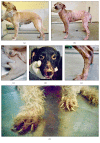Canine Leishmaniasis: An Overview of the Current Status and Strategies for Control
- PMID: 29789784
- PMCID: PMC5896350
- DOI: 10.1155/2018/3296893
Canine Leishmaniasis: An Overview of the Current Status and Strategies for Control
Abstract
Canine leishmaniasis (CanL) is a vector-borne disease caused by Leishmania infantum and is transmitted by female phlebotomine sand flies primarily between animals and secondarily to humans. The course of infection may be different from one individual dog to another, ranging from spontaneous cure to acute evolution that leads to death, if proper management and therapy are not adopted. A parasitological cure is rarely achieved and clinical recurrences in CanL are frequent. Vaccination associated with the use of topical insecticides is undoubtedly the most effective form of prevention and control of the disease. In order to integrate the most important scientific knowledge of the literature in one objective publication, this review proposes a short overview of the main points of CanL.
Figures

References
-
- World Health Organization. Report of the meeting of the WHO Expert Committee on the Control of Leishmaniases. Geneva, Switzerland: 2010. Control of the leishmaniasis. Vol. 9492010.
-
- Tsakmakidis K., Dovas C. I. Leishmania infection in rodents in Greece. Proceedings of the Ι. Tsakmakidis; 2017; pp. 1523–1532. - PubMed
Publication types
MeSH terms
Substances
LinkOut - more resources
Full Text Sources
Other Literature Sources
Medical

